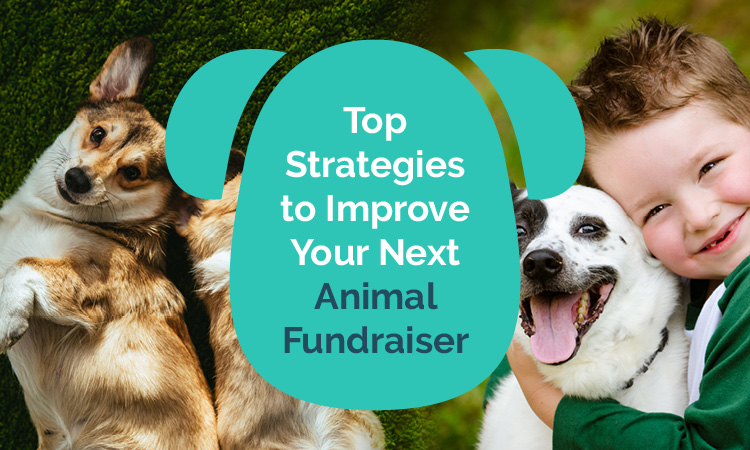
Hosting a fundraiser to raise money for your animal shelter or animal advocacy group can sometimes feel daunting. With so many worthy causes in need of critical financial support, how do you make yours stand out from the crowd?
Luckily, there are a number of proven fundraising strategies that can help set you on the right path. In this guide, we’ve compiled four of the most important approaches to help your animal fundraiser garner attention, earn more, and make the biggest impact possible. We’ll look at how to:
- Develop local partnerships.
- Leverage multichannel communications.
- Optimize your donation form.
- Show your gratitude.
All four of these tips are designed to adapt to a wide range of animal fundraising contexts and communities. As you read through, consider how each one can be adjusted to best fit your nonprofit’s unique situation.
For example, when hosting a unique community event, a small, regional animal shelter might hold an in-person event at a local dog daycare or pet store. On the other hand, a national organization might hold a virtual event to reach a broader cross-section of its supporters.
With this in mind, let’s begin by taking a deeper look at the role partnerships can play in your next animal fundraiser.
1. Develop local partnerships.
You don’t need to host your animal fundraiser alone! In fact, leveraging partnerships with trusted local businesses and like-minded nonprofits can make a dramatic difference for an animal fundraiser and offer your team much-needed support.
While direct financial sponsorship is a favorite (for a reason!) for many nonprofits, it’s just one of many ways a partner can support your fundraising efforts. As you develop partnerships, consider these additional ways in which they might benefit your animal fundraiser:
- In-kind support. Even if a business doesn’t have cash available to donate to your fundraiser, they may be able to donate extra supplies and materials, or let you use their space to host an event.
- Brand recognition and publicity. For example, if you partnered with a local dog daycare to host an event at their storefront, they could leverage their dog daycare software to share the event details with their database of customers.
- Volunteering. A business or nonprofit partner might encourage their staff to volunteer their time to support your fundraiser.
Ultimately, being open to these alternative forms of partnerships opens your organization up to additional support and maximizes your fundraising potential.
That said, remember that a partnership of any kind is a two-way street. When soliciting support from local partners, explain what they’ll gain from the partnership, such as positive publicity from supporting a good cause or additional customers.
2. Leverage multichannel communications.
If you’re only reaching out to potential supporters via one channel of communication, you’re likely missing a good portion of those who might want to support your cause. If your potential supporters don’t know about your fundraiser in the first place, it can’t get their support.
That’s where multichannel communication comes in. By marketing your animal fundraiser across a variety of platforms and mediums, this approach allows you to simultaneously:
- Connect with supporters who have a range of communication preferences for how and when they want to be contacted.
- Reach supporters on multiple devices, multiple times, increasing the likelihood that they’ll make a donation.
Thus, when planning your multichannel communication strategy, consider a combination of the following mediums:
- Social media (Twitter, Instagram, Facebook)
- Direct mail and fundraising flyers
- Email campaigns
- Digital advertisements
Many of these types of communication can be effectively leveraged at an extremely low cost to your organization. For example, Google’s Ad Grants Program offers eligible nonprofits $10,000 in free credits each month to use on digital ads. Posting on social media, too, won’t cost your organization any money, and if your online network shares these posts, they can reach potential supporters unfamiliar with your organization.
3. Optimize your donation form.
For your fundraiser’s supporters, donating should be easy and rewarding. A streamlined, intuitive donation form that guides donors through the donation process is crucial in defining the donation experience. You can set your donation page up for success by:
- Using an integrated payment processor that embeds donation forms directly into your existing site.
- Adding suggested gift amounts to encourage donors to increase their giving.
- Implementing security features to protect personal and credit card information.
- Leveraging a matching gifts database to identify donors who work for companies that will double eligible gifts.
- Optimizing for mobile use so that donors can easily make contributions to your fundraiser while on the go.
When optimizing your donation form, don’t forget to implement the same accessible design practices you do on all of your nonprofit’s pages, including alternative text for images, adjustable font, and a high-contrast background.
4. Show your gratitude.
Finally, no fundraiser is complete without a “thank you” from your organization to your donors. At the very least, you should send every donor a note that shares your appreciation for their support. Your thank-you letters should be:
- Personalized. To show donors that they’re more than a number, refer to them by name and title and reference their past involvement in your organization.
- Timely. For donations made online or by text-to-donate, most donors expect an immediate confirmation and thank-you message. According to Gingr, a robust software solution can streamline this process, automatically sending a personalized message immediately after a donation is received.
- Meaningful. Show donors that their donation to your fundraiser will make a difference in your community by sharing a combination of quantitative data and anecdotal impact stories.
- Useful. Include the information necessary for supporters to deduct their donations on their taxes as well as additional opportunities for them to get involved.
Showing gratitude to your animal fundraiser donors isn’t just the right thing to do. It also helps deepen relationships and makes it more likely for these supporters to continue (and likely increase) their support in your future fundraisers.
Ultimately, a powerful animal fundraiser doesn’t come together overnight. Rather, to produce the best results, you should develop a comprehensive plan for your fundraiser, detailing everything from the specific roles and responsibilities your team members will take on to the connections you’ll leverage to the software and tools you’ll use.
By planning the steps you’ll take ahead of time and gathering feedback from relevant stakeholders, you’ll be able to avoid confusion, streamline processes, and create an impactful, memorable fundraising experience. Good luck!
This post was contributed by Casey Dorman from Gingr.
Hi, I’m Casey! I’m the Sales Manager at Gingr software. Originally from Indianapolis, I now live in Colorado with my wife and dog, Dexter. Our hobbies include hiking, skiing, and visiting local breweries.
